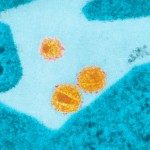Link to Pubmed [PMID] – 27473399
Retrovirology 2016 Jul;13(1):50
BACKGROUND: Covariation is an essential process that leads to coevolution of parts of proteins and genomes. In organisms subject to strong selective pressure, coevolution is central to keep the balance between the opposite requirements of antigenic variation and retention of functionality. Being the viral component most exposed to the external environment, the HIV-1 glycoprotein gp120 constitutes the main target of the immune response. Accordingly its more external portions are characterised by extensive sequence heterogeneity fostering constant antigenic variation.
RESULTS: We report that a single polymorphism, present at the level of the viral population in the conserved internal region C2, was sufficient to totally abolish Env functionality when introduced in an exogenous genetic context. The prominent defect of the non-functional protein is a block occurring after recognition of the co-receptor CCR5, likely due to an interference with the subsequent conformational changes that lead to membrane fusion. We also report that the presence of compensatory polymorphisms at the level of the external and hypervariable region V3 fully restored the functionality of the protein. The functional revertant presents different antigenic profiles and sensitivity to the entry inhibitor TAK 779.
CONCLUSIONS: Our data suggest that variable regions, besides harbouring intrinsic extensive antigenic diversity, can also contribute to sequence diversification in more structurally constrained parts of the gp120 by buffering the deleterious effect of polymorphisms, further increasing the genetic flexibility of the protein and the antigenic repertoire of the viral population.
